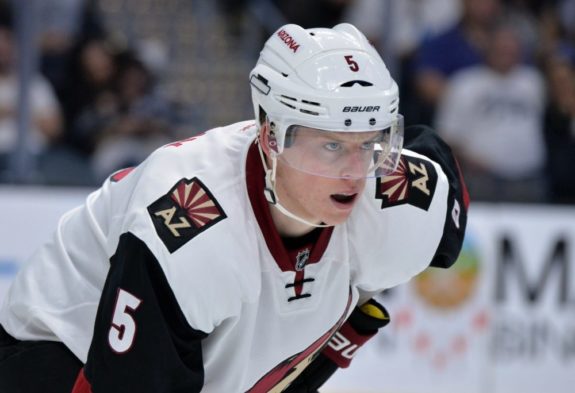To stay competitive in the very balanced NHL, young teams need to learn and grow. For the Arizona Coyotes, that lesson was learned over the opening weeks of February.
After failing to capitalize on playing with a lead in their previous game against Montreal, the Coyotes faced a similar situation in their subsequent contest with the Pittsburgh Penguins at home. More importantly, the Coyotes started slowly in recent games, and the consequence forced this young to play from behind.
Losing two, one-goal leads against the Canadiens on Feb. 9, the Coyotes prepared themselves for a challenging Penguins team that came into the game with the third-best points record in the NHL.
Watching a two-goal, third period lead melt away like an ice cream cone in the searing desert heat, the Coyotes reversed their fortune and managed to pull out a 4-3 overtime victory over the Penguins before 15,879 at Gila River Arena.
Playing With A Lead
Playing with a 3-1 advantage late in this one, an uncharacteristic error from Arizona goalie Mike Smith in his crease led to Josh Archibald’s shorthanded goal. Then, with 14 seconds left in regulation, the Penguins’ Phil Kessel flipped in his own rebound to send this into overtime. Arizona defenseman Connor Murphy turned the frown around with his first career overtime goal and the Coyotes managed to save their soul.
That helped the Coyotes to glean a valuable lesson and one they say they are not doomed to repeat.
“We can’t sit back,” winger Tobias Rieder told The Hockey Writers. “If you sit back, any team, especially one like Pittsburgh, will burn you badly. You have to keep your foot on the gas.”
Whether the situation calls for greater puck management, increased disciplined throughout the game or better positioning, the Coyotes seem to say the right things. Execution, on the other hand, is another topic.
Falling behind on Archibald’s first NHL goal at 5:41 of the second period, the Coyotes responded with Rieder’s tally and two goals from Martin Hanzal. That created the two-goal advantage and then, the breakdown.
Some would argue there was no breakdown but only a bad break.
“I thought we were in control until that one mistake,” said coach Dave Tippett. “Look, Smith bailed out his team with key saves through this game and then the offense bailed him out with the overtime goal.”
The “bad break” referred to Smith’s failure to handle the puck in the vicinity of his crease. With Rieder off for interference late in the final period, the puck came back to Smith, who is regarded as one of the better stick-handling goalies in the NHL. When Smith could not control the puck, Archibald was right now on his heels to poke in his second of the game. That set the stage for Kessel’s game-tying goal.

Poor Ice Conditions Blamed
Afterwards, Smith blamed poor ice conditions and indicated, “the puck stopped right at the goal line. It landed in a slushy pile and I couldn’t get my stick on it. This is not an excuse, but the ice in his building is bad and something has to be done about this.”
Still, the failure to hold a lead late in this game represented the bottom line. Though the Coyotes have two months remaining on their schedule, they need to show things attempted result in progress
Good teams find ways to win and for the Coyotes to pose a clear, direct challenge to any opponent, they need to know how to play with a lead.